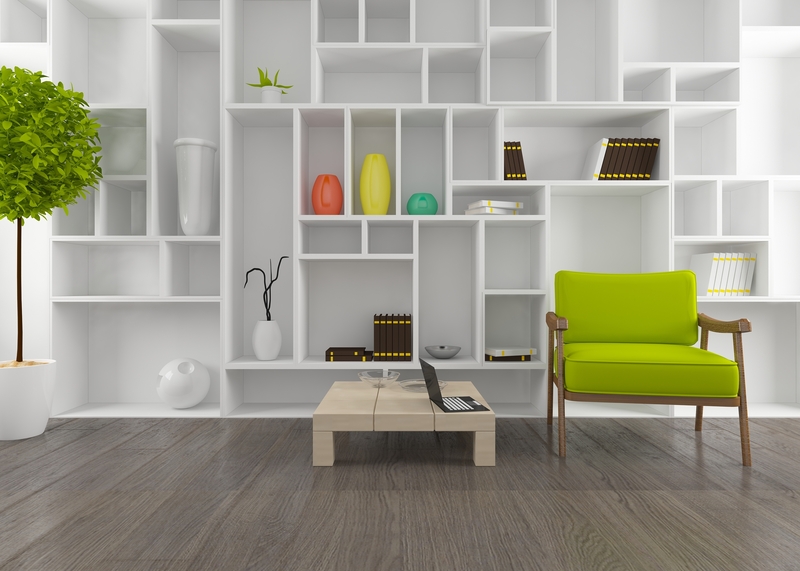Moving Your Bed and Mattress with Ease and Efficiency
Posted on 20/06/2025
Moving Your Bed and Mattress with Ease and Efficiency: A Complete Guide
Moving to a new home is an exciting adventure, but it can also be overwhelming, especially when it comes to transporting your bed and mattress. These bulky and often heavy pieces of furniture require careful planning and specific techniques to ensure they make the journey safely and efficiently. In this comprehensive guide, we'll explore expert tips and best practices for moving your bed and mattress with ease and efficiency, ensuring your relocation is as stress-free as possible.

Why Careful Bed and Mattress Moving Matters
Your bed provides comfort and support every night, and your mattress is an investment in your health and well-being. Improper handling during a move can lead to damaged frames, stained upholstery, or a mattress that loses its shape and support. By following the right steps, you prolong the life of your bed set and guarantee a restful night's sleep in your new home.
- Protect your investment: High-quality beds and mattresses can be costly to replace
- Health benefits: Avoid exposure to dirt, allergens, and pests during transit
- Guarantee comfort: Ensure your bed stays intact for continued good sleep
Preparation: Essential Before Moving Your Bed and Mattress
Gather the Right Supplies
To make moving your bed and mattress efficient and safe, start by collecting necessary moving supplies. Having these items on hand will help you move your bed and mattress with ease:
- Mattress bags or covers
- Plastic wrap and packing tape
- Moving blankets or furniture pads
- Disassembling tools (screwdrivers, Allen wrenches, pliers)
- Labels and zip-lock bags for hardware
- Dollies or hand trucks
- Straps or rope
- Markers for labeling
- Moving boxes for bed hardware and accessories
Tip: Mattress bags are specifically designed to protect against dust, moisture, and tears. Always use one when moving!
Measure Doorways, Hallways, and Staircases
Before you start, measure your mattress and bed frame, then check all pathways from your current bedroom to the moving vehicle. This step is crucial for an efficient bed and mattress move, ensuring you won't struggle with tight corners or get stuck midway.
- Measure the height, width, and thickness of your mattress and the dimensions of your bed frame (when disassembled).
- Note the size of all doorways, hallways, staircases, and elevator doors.
Pro move: Sketch a simple route plan for the quickest, least obstructed way out!
Clean and Prepare Your Bed and Mattress
Take this opportunity to clean your mattress and bed. Dust and debris can accumulate, and starting fresh helps maintain good hygiene in your new home.
- Vacuum the mattress and both sides of the headboard and footboard.
- Spot-clean any stains with an approved upholstery or mattress cleaner.
- Let everything dry completely before wrapping to prevent mildew.
- Remove bedding, pillows, and mattress toppers and pack separately.
Disassembling the Bed Frame: Step-by-Step Process
Most beds are easier and safer to move when taken apart. Here's how you can move your bed frame efficiently:
1. Remove the Mattress and Bedding
- Take off all linens, mattress protectors, and accessories.
- Store them in labeled boxes or bags for easy setup at your new place.
2. Disassemble the Bed Frame
- Carefully dismantle the bed frame, starting with the headboard and footboard.
- Use the appropriate tools to unscrew bolts and separate joints.
- Keep all nuts, bolts, and hardware in a small, labeled zip-lock bag.
- Attach the bag securely to the frame or pack it in a clearly labeled moving box.
Safety reminder: If your bed has a center support, brackets, or special connectors, check the manufacturer's manual for disassembly instructions.
3. Protect Bed Frame Components
- Wrap all pieces in moving blankets or furniture pads.
- Secure the protective covering with packing tape or stretch wrap.
- Be careful not to place tape directly on wooden or finished surfaces.
This step keeps your bed frame scratch- and dent-free during the move.
How to Move a Mattress Without Damage
Encase the Mattress for Protection
One of the best tips for moving a mattress effortlessly is to use a mattress bag. These thick plastic or vinyl covers create a barrier against dirt, moisture, and potential tears.
- Slide your mattress into the bag and seal it with packing tape.
- If you lack a mattress bag, wrap your mattress in several layers of plastic wrap or mover's blankets.
- Clearly label the size and orientation (top/bottom, head/foot) for easier unpacking.
Carry the Mattress Safely
Mistakenly bending or dragging a mattress can irreversibly damage its springs, foam, or outer fabric. Here's how to move your mattress efficiently and safely:
- Always move with at least one other adult for even support.
- Use proper lifting technique--bend your knees and keep your back straight.
- Carry the mattress on its side whenever possible, especially in tight spaces.
- Never drag the mattress on the floor.
- If available, use mattress moving straps or a dolly with straps.
For memory foam or latex mattresses: These are heavier and floppier; support their entire length to avoid sagging or tears.
Transporting Your Bed and Mattress: Loading and Securing in the Vehicle
Loading the Mattress in the Truck or Van
- If possible, load your mattress upright (on its edge) along the side wall of the moving truck.
- Secure it tightly with straps or rope to prevent shifting during transit.
- Never place heavy items on top of the mattress.
- If the mattress must lie flat, make sure it is the last item loaded and the first to be removed.
Bed Frame Placement
- Lay long pieces (side rails, slats) flat and secure them to truck walls to minimize movement.
- Avoid stacking other furniture on top of wooden bed parts to prevent dents or scratches.
- Group all frame parts together and keep the hardware bag nearby for quick assembly at your destination.
Tip: If you're moving other furniture, keep your mattress and bed frame separate from objects with sharp corners or heavy weight.
Setting Up Your Bed and Mattress at the New Home
Unpack and Inspect
After a successful move, it's tempting to crash on your bed right away. But first, inspect your mattress and bed frame for any signs of damage, moisture, or lost parts.
- Remove all wrapping and allow the mattress and frame parts to air out.
- Wipe down all surfaces to remove transit dust or particles.
- Check that all hardware and connectors are present.
Reassemble with Ease
- Follow any instructions or photos you took during disassembly.
- Start with the bed frame, attaching the headboard, footboard, and side rails.
- Secure all fasteners, brackets, or slats tightly.
- Once the frame is stable, carefully lay the mattress on top.
- Add bedding and enjoy your refreshed sleep sanctuary!
Extra Tips for Moving Different Bed and Mattress Types
Moving Platform Beds
- Platform beds often have heavy, large bases. Disassemble as much as possible.
- Use an extra pair of hands to prevent damage to slats or drawers.
- Label sections for easy reassembly.
Moving Adjustable Beds
- Disconnect power supplies, cables, and remote controls.
- Keep electronics in a separate padded box.
- Transport motors and moving parts upright and cushioned.
Moving Memory Foam and Hybrid Mattresses
- These mattresses bend, but too much flex can damage the foam or coil structure.
- Avoid folding; keep as flat as possible during transit.
- Use a thick mattress bag and support from underneath.
Should You Hire Professional Movers for Your Bed and Mattress?
If you have a particularly heavy bed set, live in a building with stairs, or want the easiest way to move a mattress, consider hiring professional movers. Here's why:
- Expert handling: Movers use the right equipment and techniques.
- Time-saving: Professionals work quickly and efficiently.
- Damage minimization: Insured services can cover accidental damage.
- Convenience: Less physical strain and hassle for you.
Just make sure to compare quotes and check reviews to find a reliable service specializing in moving mattresses and beds.

Frequently Asked Questions About Moving Beds and Mattresses
Can I fold my mattress to fit in my car?
Most traditional innerspring mattresses should never be folded, as this will ruin the coils or structure. Some memory foam mattresses may be temporarily bent but always check with the manufacturer first. As a rule, use a vehicle that fits the mattress flat or on its side.
Do I need a mattress bag?
Yes, a mattress bag or cover is essential for keeping dust, moisture, and pests away during the move.
How can I move a bed if I'm alone?
It's highly recommended to ask for help, but for smaller bed frames, you can disassemble and move pieces individually. For mattresses, use a dolly or rolling cart, and always move slowly to avoid injury.
What's the safest way to carry a mattress?
Carry mattresses on their side with two people, holding firmly near the bottom. Use moving straps if available.
Conclusion: Making Bed and Mattress Moving Easy and Efficient
Moving your bed and mattress with ease and efficiency is entirely possible with the right planning, tools, and techniques. By measuring spaces, disassembling frames, protecting your mattress, and handling each item with care, you'll ensure every part of your sleep sanctuary travels safely to your new home. Whether you move independently or with professional help, use this detailed guide as your go-to companion. With a little advance effort, you'll be ready to enjoy restful nights in your new place--starting from the very first evening!
Ready to move your bed and mattress the smart way? Use this checklist, gather your supplies, recruit help, and move with confidence--your best sleep awaits!

_result.jpg)
_result.jpg)




